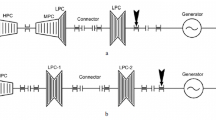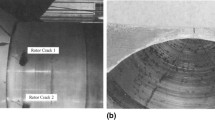Abstract
Turbine-generator shafts are often subjected to a complex transient torsional loading. Such a torsional loading may initiate yielding at the outer radius of the shaft or in the fillets. The methods for predicting turbine-shaft fatigue life due to transient loading depent upon the mode of crack growth from an undetected crack. The most common location for the existence of a crack is the fillets or shoulders of the shaft.
Specimens were designed from AISI 4340 steel with two diametrically opposed flat surfaces. Initial defect orientations of 0 deg, 45 deg and 90 deg with respect to the sepcimen axis on the fillet were studied. The specimens were subjected to cyclic torsion with zero mean torque and with a torque amplitude necessary to cause yielding at the outer radius of the specimen. When initial defects were aligned with a plane of maximum shear stress (0 deg and 90 deg), the cracks propagated along that plane. For 45-deg defects (aligned to a plane of maximum tensile stress) the crack still propagated along the plane of maximum shear. However, the number of cycles to initiate and to propagate the crack to failure for 45-deg defects were (two to three times) larger than those for 0-deg and 90-deg defects.
Mode II and Mode III crack-growth rates were measured from specimens containing 0-deg and 90-deg defects. It was found that the crack-growth rate in Mode II was higher than in Mode III. However, all the specimens failed due to reduction of the net cross section, mostly attributed to Mode III crack growth. Similar results were obtained from specimens of turbine-shaft material (A469 steel), and 2024 aluminum with different rolling directions.
Fatigue-crack-growth rates in Mode III were measured from circumferentially notched bar. They were found to be a unique function of ΔK III alternating stress intensity in Mode III. It was found that the mechanism of crack growth is produced by the formation and linkage of elongated cavities at the crack tip.
Similar content being viewed by others
References
Quay, R. and Placek, R.J., “Cyclic Fatigue of Turbine-Generator Shaft, Analysis and Control of Subsynchronous Resonance”, IEE Power Eng. Soc., New York, 12–21 (1976).
Jackson, M.C., Umans, S.D., Dunlop, R.D., Horowitz, S.H. andParikh, A.C., “Turbine-Generator Shaft Torques and Fatigue: Part I: —Simulation Methods and Fatigue Analysis”,IEEE Trans. on Power Apparatus and Systems,PAS-98,2299–2307 (1979).
Dunlop, R.D., Horowitz, S.H., Parikh, A.C. andJackson, M.C., “Turbine-Generator Shaft Torques and Fatigue: Part II — Impact of System Disturbance and High Speed Reclosure”,IEEE Trans. on Power Apparatus and Systems,PAS-98,2308–2328 (1979).
Walker, D.N., Bowler, C.E.J., Jackson, R.L. andHodges, D.A., “Results of Subsynchronous Resonance Test at Mohave,”IEEE Trans. on Power Apparatus and System,PAS-94,1878–1889 (1975).
Lokay, H.E., Ramey, D.G. andBrose, W.R., “Turbine-Generator Shaft Loss of Life Concepts for Power System Disturbance”,Proc. Amer. Power Conf.,40,1106–1115 (1978).
Brown, P.G. and Quay, R. “Transmission Line Reclosing-Turbine Generator Duties and Stability Considerations”, 29th Annual Conf. for Protective Relay Engs. at Texas A & M Univ. (1976).
Dieter, G.E., “Mechanical Metallurgy”, 2nd Ed., McGraw-Hill, 415 (1976).
Ritchie, R.O., McClintock, F.A., Nayeb-Hashemi, H. and Ritter, M.A., “Mode III Fatigue Crack Propagation in Low Alloy Steel,” Met. Trans. A, 12A (1981).
Placek, R., Williams, R., Klufas, O. and Adams, S., “EPRI-G.E. Workshop on Torsional Fatigue Strength of Large Turbine-Generator Shafts RP1531”, Schenectady, NY (Sept. 1980).
Timoshenko, S.P. and Goodier, J.N., “Theory of Elasticity”, McGraw-Hill Book Co., 297–299 (1970).
Baumeister, T. and Marks, L.S., “Standard Handbook for Mechanical Engineers”, 7th Ed., McGraw-Hill Book Co., 5–52 (1967).
Nayeb-Hashemi, H., McClintock F.A. andRitchie, R.O., “Micro-Mechanical Modeling of Mode III Fatigue Crack Growth in Rotor Steels”,Int. J. of Fract.,23,163–185 (1983).
Nayeb-Hashemi, H., “Design of a Wood's Metal Grip for Torsion Tests”,Experimental Techniques,10 (4),34–37 (1986).
Ritter, M.A. andRitchie, R.O., “On the Calibration, Optimization and Use of D.C. Electric Potential Methods for Monitoring Mode III Crack Growth in Torsionally-Loaded Samples”,Fatigue of Eng. Mat. and Struct.,5 (1),91–99 (1982).
Tada, H., Paris, P.C. andIrwin, G.R., “The Stress Analysis of Cracks Handbook”,Del. Res. Corp., Hellertown, PA (1973).
Author information
Authors and Affiliations
Rights and permissions
About this article
Cite this article
Nayeb-Hashemi, H. Failure modes of specimens containing surface flaws under cyclic torsion. Experimental Mechanics 27, 51–56 (1987). https://doi.org/10.1007/BF02318863
Received:
Accepted:
Issue Date:
DOI: https://doi.org/10.1007/BF02318863




